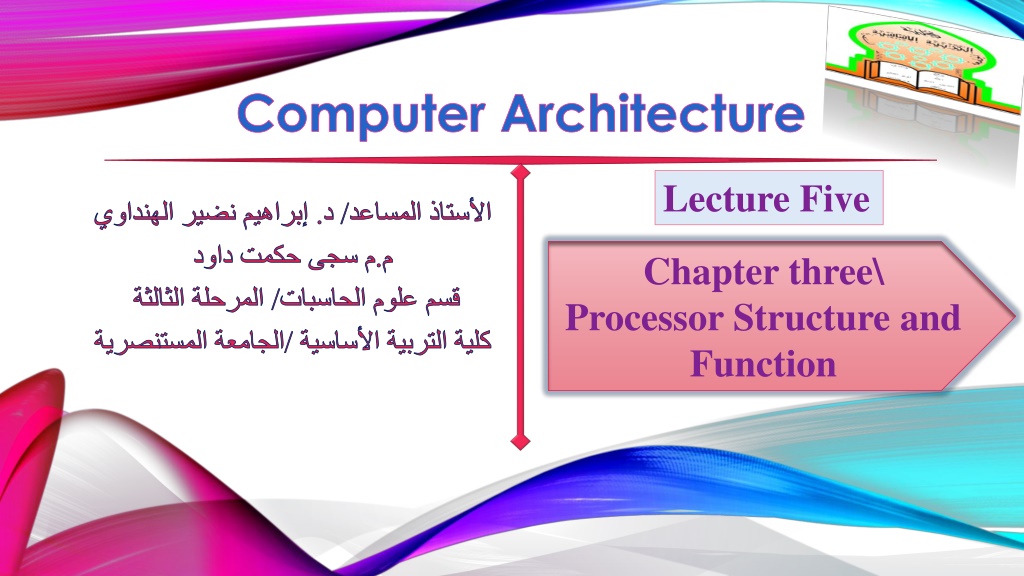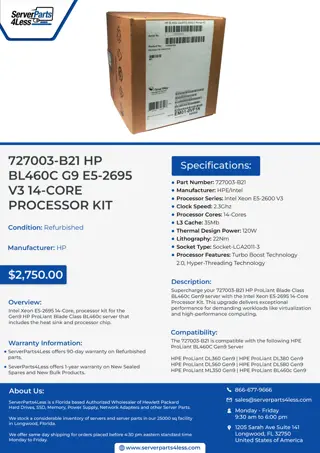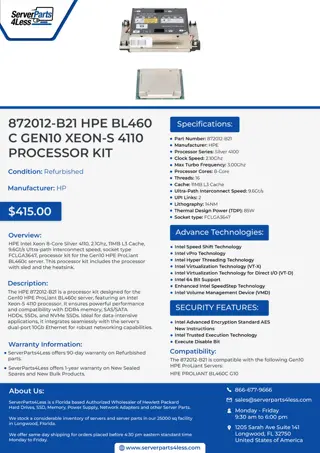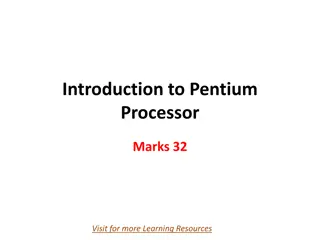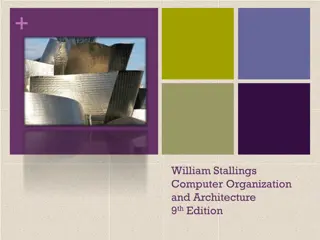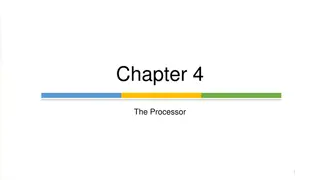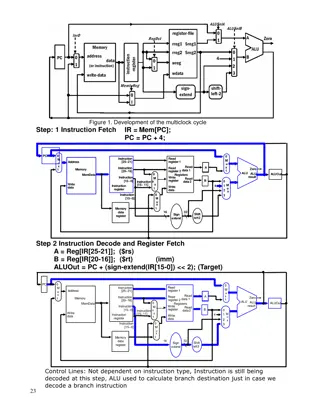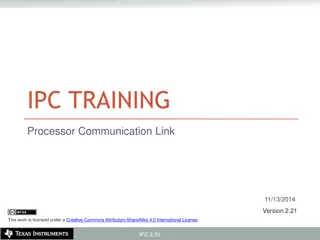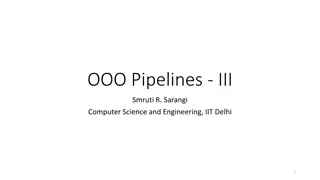Understanding Processor Organization in Computer Architecture
Processor organization involves key tasks such as fetching instructions, interpreting instructions, processing data, and storing temporary data. The CPU consists of components like the ALU, control unit, and registers. Register organization plays a crucial role in optimizing memory usage and controlling processor operations.
Download Presentation

Please find below an Image/Link to download the presentation.
The content on the website is provided AS IS for your information and personal use only. It may not be sold, licensed, or shared on other websites without obtaining consent from the author. Download presentation by click this link. If you encounter any issues during the download, it is possible that the publisher has removed the file from their server.
E N D
Presentation Transcript
Computer Architecture Lecture Five . / / . Chapter three\ Processor Structure and Function /
2 Processor Organization To understand the processor organization, we should consider the things that it must do: Fetch instruction: The processor reads an instruction from memory (register, cache, main memory). Interpret instruction: The instruction is decoded to determine what action is required. Fetch data: The execution of an instruction may require reading data from memory or an I/O module. Process data: The execution of an instruction may require performing some arithmetic or logical operation on data. Write data: The results of an execution may require writing data to memory or an I/O module.
3 To do these the processor needs to store some data temporarily. It must remember the location of the last instruction so that it can know where to get the next instruction. Storing instructions and data temporarily while an instruction is being executed. In other words, the processor needs a small internal memory. As we all might know that the major components of the processor are an arithmetic and logic unit (ALU) and a control unit (CU).The ALU does the actual computation or processing of data. The control unit controls the movement of data and instructions into and out of the processor and controls the operation of the ALU. In addition, the processor contains a minimal internal memory, consisting of a set of storage locations, called registers.
Internal Structure of the CPU 4 The internal processor bus is needed to transfer data between the various registers and the ALU because the ALU in fact operates only on data in the internal processor memory.
5 Register Organization At higher levels of the hierarchy, memory is faster, smaller, and more expensive (per bit).Within the processor, there is a set of registers that function as a level of memory above main memory and cache in the hierarchy. The registers in the processor perform two roles: User-visible registers: Enable the machine- or assembly language programmer to minimize main memory references by optimizing use of registers. Control and status registers: Used by the control unit to control the operation of the processor and by privileged, operating system programs to control the execution of programs.
6 A user-visible register is one that may be referenced by means of the machine language that the processor executes. These include: General-purpose registers can be assigned to a variety of functions by the programmer. They can contain the operand for any opcode. Data registers may be used only to hold data and cannot be employed in the calculation of an operand address. Address registers may themselves be somewhat general purpose, or they may be devoted to a particular addressing mode. Examples include; Segment pointers, Index registers, Stack pointer. Flag registers which hold condition codes (also referred to as flags), which is at least partially visible to the user. Condition codes are bits set by the processor hardware as the result of operations
7 On the other hand, Control and Status Registers, are employed to control the operation of the processor. Most of these are not visible to the user. Some of them may be visible to machine instructions executed in a control or operating system mode. These registers are including: Program counter (PC): Contains the address of an instruction to be fetched Instruction register (IR): Contains the instruction most recently fetched Memory address register (MAR): Contains the address of a location in memory Memory buffer register (MBR): Contains a word of data to be written to memory or the word most recently read.
8 Instruction Cycle An instruction cycle includes the following stages: Fetch: Read the next instruction from memory into the processor. Execute: Interpret the opcode and perform the indicated operation. Interrupt: If interrupts are enabled and an interrupt has occurred, save the current process state and service the interrupt.
9 Data Flow To exact sequence of events during an instruction cycle a general terms what must happen. Let us assume that a processor that employs a memory address register (MAR), a memory buffer register (MBR), a program counter (PC), and an instruction register (IR). During the fetch cycle, an instruction is read from memory. The PC contains the address of the next instruction to be fetched. This address is moved to the MAR and placed on the address bus. The control unit requests a memory read, and the result is placed on the data bus and copied into the MBR and then moved to the IR. Meanwhile, the PC is incremented by 1, preparatory for the next fetch. Once the fetch cycle is over, the control unit examines the contents of the IR to determine if it contains an operand specifier using indirect addressing. If so, an indirect cycle is performed.
10 The execute cycle takes many forms; the form depends on which of the various machine instructions is in the IR. This cycle may involve transferring data among registers, read or write from memory or I/O, and/or the invocation of the ALU. Like the fetch and indirect cycles, the interrupt cycle is simple and predictable. The current contents of the PC must be saved so that the processor can resume normal activity after the interrupt. Thus, the contents of the PC are transferred to the MBR to be written into memory. The special memory location reserved for this purpose is loaded into the MAR from the control unit. It might, for example, be a stack pointer. The PC is loaded with the address of the interrupt routine. As a result, the next instruction cycle will begin by fetching the appropriate instruction.
11 INSTRUCTION PIPELINING The enhancements of processor organizational can improve performance. We have already seen some examples of this, such as the use of multiple registers rather than a single accumulator, and the use of a cache memory. Another organizational approach, which is quite common, is instruction pipelining. Pipelining Strategy Instruction pipelining is similar to the use of an assembly line in a manufacturing Plant To apply this concept to instruction execution; we must recognize that, in fact, an instruction has a number of stages
12 As a simple approach, consider subdividing instruction processing into two stages: fetch instruction and execute instruction. There are times during the execution of an instruction when main memory is not being accessed. This time could be used to fetch the next instruction in parallel with the execution of the current one. Figure below depicts this approach.
13 The pipeline has two independent stages. The first stage fetches an instruction and buffers it. When the second stage is free, the first stage passes it the buffered instruction. While the second stage is executing the instruction, the first stage takes advantage of any unused memory cycles to fetch and buffer the next instruction. This is called instruction prefetch or fetches overlap. Note that this approach, which involves instruction buffering, requires more registers. In general, pipelining requires registers to store data between stages. It should be clear that this process will speed up instruction execution. If the fetch and execute stages were of equal duration, the instruction cycle time would be halved.
14 However, if we look more closely at this pipeline (Figure below), we will see that this doubling of execution rate is unlikely for two reasons:
15 1. The execution time will generally be longer than the fetch time. Execution will involve reading and storing operands and the performance of some operation. Thus, the fetch stage may have to wait for some time before it can empty its buffer. 2. A conditional branch instruction makes the address of the next instruction to be fetched unknown. Thus, the fetch stage must wait until it receives the next instruction address from the execute stage. The execute stage may then have to wait while the next instruction is fetched.
16 Guessing can reduce the time loss from the second reason. A simple rule is the following: When a conditional branch instruction is passed on from the fetch to the execute stage, the fetch stage fetches the next instruction in memory after the branch instruction. Then, if the branch is not taken, no time is lost. If the branch is taken, the fetched instruction must be discarded and a new instruction fetched.
17 To gain further speedup, the pipeline must have more stages. Let us consider the following decomposition of the instruction processing. Fetch instruction (FI): Read the next expected instruction into a buffer. Decode instruction (DI): Determine the opcode and the operand specifiers. Calculate operands (CO): Calculate the effective address of each source operand. This may involve displacement, register indirect, indirect, or other forms of address calculation. Fetch operands (FO): Fetch each operand from memory. Operands in registers need not be fetched. Execute instruction (EI): Perform the indicated operation and store the result, if any, in the specified destination operand location. Write operand (WO): Store the result in memory.
18 With this decomposition, the various stages will be of more nearly equal duration. Figure below shows that a six-stage (equal duration) pipeline can reduce the execution time for 9 instructions from 54 time units to 14 time units.
19 The diagram assumes that each instruction goes through all six stages of the pipeline. This will not always be the case. For example, a load instruction does not need the WO stage. However, to simplify the pipeline hardware, the timing is set up assuming that each instruction requires all six stages. Also, the diagram assumes that all of the stages can be performed in parallel. In particular, it is assumed that there are no memory conflicts. Several other factors serve to limit the performance enhancement. If the six stages are not of equal duration, there will be some waiting involved at various pipeline stages, as discussed before for the two-stage pipeline. Another difficulty is the conditional branch instruction, which can invalidate several instruction fetches. A similar unpredictable event is an interrupt.
20 Other problems arise that did not appear in our simple two-stage organization. The CO stage may depend on the contents of a register that could be altered by a previous instruction that is still in the pipeline. Other such register and memory conflicts could occur. The system must contain logic to account for this type of conflict.
